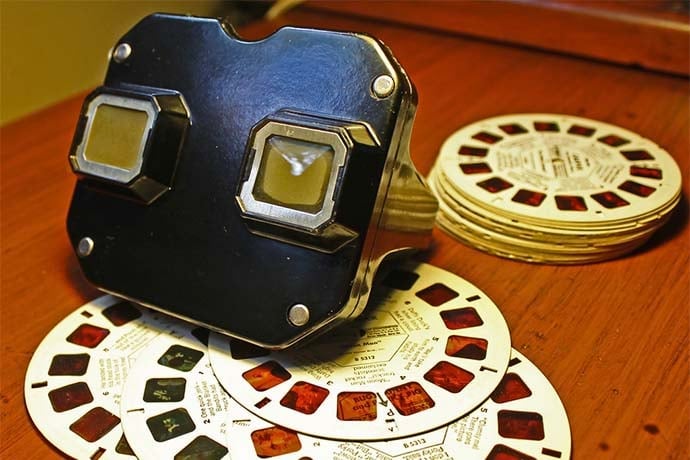People have changed the world around them, and thought about how to change the world, since the start of human history. The idea of hand held tools to transport people to different worlds, however, appears to be a mostly new idea. The popularity of HG Wells and his science fiction novels, for example, led readers and writers to think and write about how technology might change or replace the world.
What we call virtual reality can be traced back at least to a short story by Stanley G. Weinbaum, Pygmalion’s Spectacles, published in 1935. The spectacles are goggles that, when worn, transport the narrator into a paradise with people, sounds, smells, and touch. Yet the narrator is aware he actually sits in a chair in a hotel room as he wears the goggles.
Virtual reality and augmented reality also evolved for practical reasons. In the 1920s, pilots had to learn how to fly with instruments. Early pilots flew mostly by calculating fuel, airspeed, wind resistance, and other factors to determine how far they could fly. Once in the air, they flew based on touch and experience.
In 1927, Edwin Link of Binghamton, NY built a Link Trainer, a metal frame flight simulator that used instruments connected to pumps and switches to simulate actual instrument flight. Pilots could train without the restrictions of weather and availability of planes and teachers. The Link Trainer eventually added movies and were heavily used in World War II. In the 1950s, flight simulators evolved into what we’re familiar with today. Here’s how a Link Trainer worked in the 1940s:
Development of personal virtual and augmented reality began in the 1960s with research done by Ivan Sutherland at MIT and the University of Utah. He and his students created the first head mounted displays and started to solve problems like eye tracking and depth perception. Jaron Lanier in the 1980s helped popularize the idea of virtual reality, and at least one attempt at a virtual reality game failed. However, computers were not powerful enough, a few technical problems had to be solved, and the cost of the technology limited its appeal.
The image below, from the current issue, presents this story as text and images. Right mouse-click the image to open it in a new tab and see it full size. Or download the PDF file.

Learn More
What is Virtual Reality?
http://www.vrs.org.uk/virtual-reality/what-is-virtual-reality.html
http://www.theatlantic.com/magazine/archive/2015/10/virtual-reality-gets-real/403225/
https://medium.com/@blaurel/what-is-virtual-reality-77b876d829ba#.8zpk1nbl7
History of Virtual Reality
https://youtu.be/43mA_ypfwKg
http://bibblio.org/o/MJ/reality-check-a-history-of-virtual-reality
How Does Virtual Reality Work?
Virtual Reality vs Augmented Reality
https://www.thefoundry.co.uk/solutions/virtual-reality/vr-ar-mr-sorry-im-confused/
http://www.adnews.com.au/opinion/ar-vs-vr-why-augmented-reality-is-winning-the-race
http://www.augment.com/blog/virtual-reality-vs-augmented-reality/
Augmented Reality
https://en.wikipedia.org/wiki/Augmented_reality
https://en.wikipedia.org/wiki/List_of_augmented_reality_software
Stanley G. Weinbaum
https://en.wikipedia.org/wiki/Stanley_G._Weinbaum
Link Trainer
https://en.wikipedia.org/wiki/Link_Trainer
https://youtu.be/5kmmKj7fbnI
https://en.wikipedia.org/wiki/Edwin_Albert_Link
Flight Simulators
https://en.wikipedia.org/wiki/Flight_simulator
Ivan Sutherland
https://en.wikipedia.org/wiki/Ivan_Sutherland
http://design.osu.edu/carlson/history/PDFs/p757-sutherland.pdf
http://jalopnik.com/the-first-real-object-ever-3d-scanned-and-rendered-was-494241353
Sword of Damocles
https://en.wikipedia.org/wiki/The_Sword_of_Damocles_(virtual_reality)
Head Mounted Display
https://en.wikipedia.org/wiki/Head-mounted_display
Sensorama
https://en.wikipedia.org/wiki/Sensorama
http://www.mortonheilig.com/InventorVR.html
http://www.sensorama3d.com/sensorama2.html
Jaron Lanier
https://en.wikipedia.org/wiki/Jaron_Lanier
https://www.theguardian.com/technology/2001/dec/29/games.academicexperts
Virtual Boy Game
https://en.wikipedia.org/wiki/Virtual_Boy
http://www.androidcentral.com/unofficial-virtual-boy-lets-you-enjoy-classic-nintendo-games-google-cardboard
HTC Vive
https://www.htcvive.com/
https://en.wikipedia.org/wiki/HTC_Vive
Oculus Rift
https://www.oculus.com/
https://en.wikipedia.org/wiki/Oculus_Rift
Samsung Gear VR
http://www.samsung.com/global/galaxy/gear-vr/
https://en.wikipedia.org/wiki/Samsung_Gear_VR
Playstation VR
https://www.playstation.com/en-us/explore/playstation-vr/
https://en.wikipedia.org/wiki/PlayStation_VR
Google Cardboard
https://vr.google.com/cardboard/
https://en.wikipedia.org/wiki/Google_Cardboard

